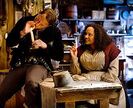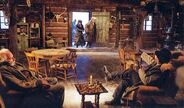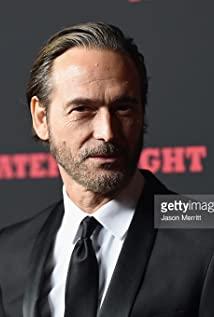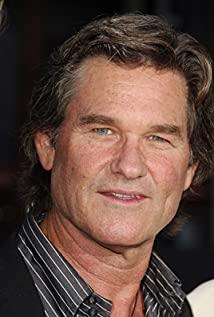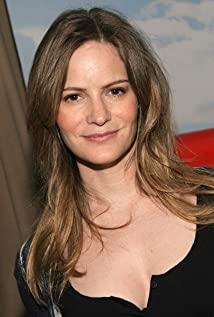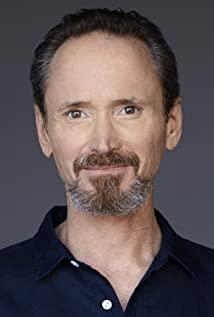"The Hateful Eight" may not be the best movie of 2015, but it should be the most interesting movie, and "no one" may have to be added. Of course, for Quentin Tarantino fans, almost every work of his can be worthy of such praise. Quentin's movies have always been not the kind that caters for all ages, big and small. However, the iron fans who followed all the way from "Falling Water Dog" and "Pulp Fiction" have long understood and liked his set of things. Those who faced "Pulp Fiction" exclaimed, "Can movies still be like this?" The audience has become accustomed to it, enjoy it and it's over. Nearly three hours of film length? I still think it's too short, I can't wait to come for another hour.
What makes people afraid is that this movie almost died out. Before the filming started in January 2014, the script of the film was tragically leaked, and Quentin said in a rage that he would not shoot at all and just publish the novel. As a result, under the hard persuasion of the lead actor Samuel Jackson and others, the old ruffian changed his mind. Regardless of whether he really wanted to pick up his son, or deliberately arrogantly, fortunately, the film came out as hoped.
"The Evil Eight" still has a distinctive Quentin mark, such as the structure of chapter style, non-linear narrative, and a large number of violent scenes. Quentin said that the film was inspired by Western TV series such as "Bernanza's Cowboy" and "The Virginian" in the 1960s. However, the story of the eight characters is easily reminiscent of the originator of the Western movie "Flying Guanshan", but Quentin replaced John Ford’s carriage with a shop. Taking into account the blockade of the snowstorm, it also constitutes a closed space. Dramatic tension.
The first three chapters of the film are quite slow, full of Quentin’s trademark-like dialogues. But anyone who knows the scriptures knows that these dialogues are not just a bad taste, but play a vital role in constructing narratives and shaping characters. Through these dialogues, the time background of the story and the character characteristics of the characters can be presented to the audience. At the same time, various details and clues (such as damaged store doors, jelly beans on the floor, missing shopkeepers, etc.) are constantly used to convey to the audience the hidden secrets of the small store. Compared to the cold outdoor, it is as warm as Chun's house seemed to be even more dreadful.
By the end of Chapter Three, Warren provoked and shot General Smithers, Quentin's violent aesthetics began to dominate the plot afterwards. From the fourth chapter "Damoge has a secret", the film's rhythm has suddenly accelerated. With the emergence of a large number of plasma, sudden accidental elements, inserted flashback storylines, and reversal of the characters, the previously buried The foreshadowing of the tenon and tenon joints one by one, the climax of the film broke out unexpectedly, and can not help but be hooked.
If "The Rescued Jiang Ge" is Quentin's first attempt at western films, then as a posterity, "The Hateful Eight" is his more extreme exploration of the themes of western films. As we all know, Quentin has two great things in this life, one is Shaw Kung Fu movies and the other is macaroni westerns. In order to pay tribute to Sergio Corbusi, Quentin set up a scene in the snow in "The Rescued Jiang Ge", and in this film, he simply put the whole film in the wind and snow. As for the inner core, Corbusi’s works are always linked to racism, which also flows in Quentin’s two films. The difference is that Quentin’s ideology expressed in "The Hateful Eight" is more complicated.
The opening shots of the film are very symbolic. The huge crucifix occupies the entire frame, and the snow on the head and neck makes the originally quiet and serene Jesus look miserable. The camera slowly zoomed out. In the background is the Rocky Mountains covered with white snow. The atmosphere is depressed and suffocated. The black of the statue forms a strong contrast with the white surrounding it. In color metaphors, white originally represents morality and purity, and black represents corruption and sin, but here it is reversed. This is Quentin's original meaning-lack of justice and collapse of faith.
Quentin has a unique feeling for black people, and his movies always involve some racial issues. However, in previous works, the opposition between justice and evil is very clear. For example, the black slave Jiang Ge and the bounty hunter Dr. Schultz in "The Freed Jiang Ge" are the righteous side, while the slave owner represented by Candi is the evil side, and in "Shameless Bastard", the pros and cons The two sides are even more distinct. At the same time, under this narrative logic, the violence of the righteous side has been "legalized", and the cruelty of the violence itself and the guilt in the audience's heart are eliminated.
However, in "The Evil Eight", the boundary between justice and evil is blurred, and everyone is evil. Needless to say, the gang headed by Duomoge brothers and sisters, but should their original identity be the role of the righteous side? Ruth, a white bounty hunter, has a clear tendency to discriminate against women, and treats the female prisoner Daisy Domoge with all his abilities to beat and scold and humiliate the female prisoner. The new sheriff of Redstone Town, Mannix, is good at seeing the wind. Change camps with the situation, and did not stop the murder in front of him, even if he was killed by the old general he respected very much; and this seemingly respected and bloody old general explained him in the flashback. In order to protect themselves when the Domoge gang slaughtered the shop, they not only turned a blind eye to the killing, but also agreed to become an accomplice afterwards.
Even Warren, a black bounty hunter who has been ridiculed and squeezed out in the first half of the film and is always in a disadvantaged position, admits to his less glorious past (the sheriff and the old general also have a dark history, and the father of the former is notorious. The leader of the rebels, the latter used inhumane means to execute black captives). He joined the Northern Army in the Civil War not to pursue justice or to defend freedom. It was an opportunity to kill whites in an upright manner. He even set fire to dozens of recruits while escaping from a prisoner-of-war camp. It can be seen that in Minnie's shop, no matter who upholds is only personal justice and personal beliefs. As a result, Quentin no longer imposes moral and value judgments on violent aesthetics, making it purer, more real, and more humane.
In "The Freed Jiang Ge", Quentin vaguely expressed his thinking on the "national level." The reason why slave owners were able to inflict legal violence on black slaves was because the American national system recognized that violence at the national level was the basis of personal violence, and the harm of national evil was far greater than personal violence. In this film, this thinking is further elaborated. Bounty hunter Warren, Sheriff Mannix, and the veteran general Smithers all had brutal and cruel acts in the Civil War, but after the war they could be transformed into decent and glamorous positive figures and even government spokespersons ( The sheriff is appointed by the government, and the bounty hunter system is also legal.) The ridicule is self-evident.
The letter from President Lincoln that Warren forged was the finishing touch. Obviously the war ended with the victory of the North, and the great Abraham Lincoln issued the "Proclamation on Emancipating the Negro Slaves", but the social reality after the war has not changed substantially, and the status of blacks has not improved at all. Even if Warren is a former Northern Army officer and now a nationally recognized bounty hunter, he still has to rely on a forged Lincoln letter to protect himself. His dialogue "You can't imagine how it feels as a black man in the United States. The only time black brothers can feel safe is when you white brothers get rid of your vigilance." Ironically, the owner, Minnie, is a black herself, but she has to put up a sign saying "Mexicans and dogs are not allowed").
Before the film was released, there were successive "Ferguson Riots" and "Baltimore Riots" in the United States. The cause was the brutal law enforcement of the white police which led to the death of blacks. In fact, nothing has changed since the Civil War. Although the bounty hunter system in those years was a supplement to the U.S. judicial system, some bounty hunters are not officially authorized cold-blooded killers who inhumane torture and kill criminals in the process of hunting and escorting them, and this kind of national level Today’s indulgence is a breeding ground for so many incidents of US military prisoner abuse and violent law enforcement.
"The Hateful Eight" has the pungency and evil that are rare in Quentin's works. It is also an evolution of his favorite violence and historical revisionism. The most commendable thing is that it presents the grand narrative of the entire country in one room. How can you not love such Quentin!
♑
View more about The Hateful Eight reviews





